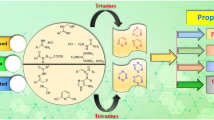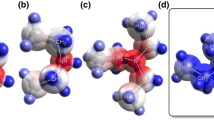Abstract
Recent progress in the research of radical anion ligands and their complexes with metals were summarized in this review. Radical anions were sorted into several types including iminosemiquinonate and iminoquinonate radical, nitroxide radical, heterocycle radical etc. Structural characteristics and properties of the corresponding complexes were introduced. The complexes exhibited novel properties and possibility for applications in organic magnetic materials and transition metal catalysis.




















Similar content being viewed by others
References
Gomberg M (1900) An instance of trivalent carbon: triphenylmethyl. J Am Chem Soc 22:757–771
Kaim W (1987) The transition metal coordination chemistry of anion radicals. Coord Chem Rev 76:187–235
Tsurugi H, Saito T, Tanahashi H et al (2011) Carbon radical generation by d0 tantalum complexes with α-diimine ligands through ligand-centered redox processes. J Am Chem Soc 133:18673–18683
Hitchcock PB, Lappert MF, Protchenko AV (2011) Synthesis and structure of the silylated benzene radical anion salts [K([18]-crown-6){C6H4(SiMe3)2-1,4}] and [K([18]crown-6)(THF)2][C6H2(SiMe3)4-1,2,4,5]. J Organomet Chem 696:2161–2164
Luneau D, Borta A, Chumakov Y et al (2008) Molecular magnets based on two-dimensional Mn(II)–nitronyl nitroxide frameworks in layered structures. Inorg Chim Acta 361:3669–3676
Dang JD, Hamer GK, Georges MK (2012) The synthesis of a verdazyl radical-derived biphenylophane. Tetrahedron Lett 53:4877–4879
Michaelis L, Hill ES (1933) Potentiometric studies on semiquinones. J Am Chem Soc 55:1481–1494
Abakumov GA, Poddel AI, Bubnov MP et al (2005) Manganese(III) and rhenium(II) complexes with bulky 4,6-di-tert-butyl-N-(2,6-di-iso-propylphenyl)-o-iminobenzoquinonato ligands via carbonyls of corresponding metals. Inorg Chim Acta 358:3829–3840
Poddel AI, Cherkasov VK, Fukin GK et al (2004) New four- and five-coordinated complexes of cobalt with sterically hindered o-iminobenzoquinone ligands: synthesis and structure. Inorg Chim Acta 357:3632–3640
Chun H, Verani CN, Chaudhuri P et al (2001) Molecular and electronic structure of octahedral o-aminophenolato and o-iminobenzosemiquinonato complexes of V(V), Cr(III), Fe(III), and Co(III). Experimental determination of oxidation levels of ligands and metal ions. Inorg Chem 40:4157–4166
Lippert CA, Hardcastle KA, Soper JD (2011) Harnessing redox-active ligands for low-barrier radical addition at oxorhenium complexes. Inorg Chem 50:9864–9878
Poddel AI, Bubnov MP, Fukin GK et al (2008) New nitrosyl bis-o-iminobenzosemiquinonato complexes of M(ISQ)2(NO) type. Z Anorg Allg Chem 634:1205–1209
Chaudhuri P, Verani CN, Bill E et al (2001) Electronic structure of bis(o-iminobenzosemiquinonato)metal complexes (Cu, Ni, Pd). The art of establishing physical oxidation states in transition-metal complexes containing radical ligands. J Am Chem Soc 123:2213–2223
Smith AL, Clapp LA, Hardcastle KI et al (2010) Redox-active ligand-mediated Co–Cl bond-forming reactions at reducing square planar cobalt(III) centers. Polyhedron 29:164–169
Kokatam S, Weyhermu1ller T, Bothe E et al (2005) Structural characterization of four members of the electron-transfer series [PdII(L)2)]n (L = o-iminophenolate derivative; n = 2−, 1−, 0, 1+, 2+). Ligand mixed valency in the monocation and monoanion with S1/2 ground states. Inorg Chem 44:3709–3717
Abakumov GA, Cherkasov VK, Druzhkov NO et al (2006) Synthesis, structures, and properties of novel N-aryl-phenanthren-o-iminoquinones. Synth Commun 36:3241–3247
Poddel AI, Smolyaninov IV, Skatovaa AA et al (2008) Diradical bis-o-iminosemiquinonato zinc complex: spectroscopy, magneto-and electrochemistry. Z Anorg Allg Chem 634:1154–1160
Piskunov AV, Mescheryakova IN, Bogomyakov AS et al (2009) Novel indium(III) complexes with sterically hindered o-iminobenzoquinone. Inorg Chem Commun 12:1067–1070
Poddel AI, Vavilina NN, Somov NV et al (2009) Triethylantimony(V) complexes with bidentate O,N–, O,O– and tridentate O,N,O–coordinating o-iminoquinonato/o-quinonato ligands: synthesis, structure and some properties. J Organomet Chem 694:3462–3469
Lado AV, Poddel AI, Piskunov AV et al (2005) Oxidative addition of 3,6-di-tert-butyl-o-benzoquinone and 4,6-di-tert-butyl-N-(2,6-di-iso-propylphenyl)-o-iminobenzoquinone to SnCl2. Inorg Chim Acta 358:4443–4450
Piskunov AV, Mescheryakova IN, Fukin GK et al (2009) New tin(IV) complexes with sterically hindered o-iminobenzoquinone ligand: synthesis and structure. Heteroat Chem 6:332–340
Piskunov AV, Aivaz’yan IA, Poddel AI et al (2008) New germanium complexes containing ligands based on 4,6-di-tert-butyl-N-(2,6-diisopropylphenyl)-o-iminobenzoquinone in different redox states. Eur J Inorg Chem 2008:1435–1444
Blackmore KJ, Ziller JW, Heyduk AF (2005) “Oxidative addition” to a zirconium(IV) redox-active ligand complex. Inorg Chem 44:5559–5561
Fedushkin IL, Khvoinova NM, Baurin AY et al (2004) Divalent germanium compound with a radical-anionic ligand: molecular structures of (dpp-BIAN)-GeCl and its hydrochloration products [(dpp-BIAN)(H)2+[GeCl3]− and [{(dpp-BIAN)(H)2+}2(Cl−)]+[GeCl3]− (dpp-BIAN = 1,2-bis{(2,6-diisopropylphenyl)imino}acenaphthene). Inorg Chem 43:7807–7815
Caneschi A, Gatteschi D, Sessoli R et al (1989) Toward molecular magnets: the metal-radical approach. Acc Chem Res 22:392–398
Caneschi A, Gatteschi D, Rey P (1991) The chemistry and magnetic-properties of metal nitronyl nitroxide complexes. Prog Inorg Chem 39:331–342
Kaizaki S (2003) Spectroscopic implications for magnetic interactions in metal complexes with nitroxide radicals. Chem Soc Jpn 76:673–688
Luneau D, Rey PC (2005) Magnetism of metal-nitroxide compounds involving bis-chelating imidazole and benzimidazole substituted nitronyl nitroxide free radicals. Chem Rev 249:2591–2611
Kaizaki SC (2006) Coordination effects of nitroxide radicals in transition metal and lanthanide complexes. Chem Rev 250:1804–1818
Zhang XH, Yang ST, Wang SP (2008) Rare earth complexes with nitroxide radicals. Chem Ind Eng Prog 20:1073–1089
Fegy K, Luneau D, Rey P et al (1998) Two-dimensional nitroside-based molecular magnetic materials. Angew Chem Int Ed 37:1270–1273
Zhang XH, Wang SP (2002) Nitroxide radical-metal complex magnetism molecular material. Chem Ind Eng Prog 21:2525–2535 (in Chinese)
Kanegawa S, Karasawa S, Maeyama M et al (2008) Crystal design of monometallic single-molecule magnets consisting of cobalt-aminoxyl heterospins. J Am Chem Soc 130:3079–3094
Caneschi A, Chiesi P, David L et al (1993) Crystal structure and magnetic properties of two nitroxide biradicals and of their copper(II) complexes. Inorg Chem 32:1445–1453
Iwamura H, Inoue K, Hayamizu T (1996) High-spin polynitroxide radicals as versatile bridging ligands for transition metal complexes with high ferri/ferromagnetic Tc. Pure Appl Chem 68:243–252
Kahn O, Galy Y, Journaux Y et al (1982) Synthesis, crystal structure and molecular conformations, and magnetic properties of a copper–vanadyl (CuII–VII) heterobinuclear complex: interaction between orthogonal magnetic orbitals. J Am Chem Soc 104:2165–2176
Journaux Y, Kahn O, Zarembowitch J et al (1983) Symmetry of the magnetic orbitals and exchange interaction in copper iron (CuIIFeIII) and copper chromium (CuIICrIII) heterobinuclear complexes. J Am Chem Soc 105:7585–7591
Kahn O (1985) Dinuclear complexes with predictable magnetic properties. Angew Chem Int Ed Engl 24:834–850
Vostrikova KE, Luneau D, Wernsdorfer W et al (2000) A S = 7 ground spin-state cluster built from three shells of different spin carriers ferromagnetically coupled, transition-metal ions and nitroxide free radicals. J Am Chem Soc 122:718–719
Kanegawa S, Karasawa S, Nakano M et al (2004) Magnetic behavior of tetrakis[4-(N-tert-butyl-N-oxylamino)pyridine]bis(isocyanato-N)cobalt(II) in frozen solution. Chem Commun 4:1750–1751
Ishii N, Okamura Y, Chiba S et al (2008) Giant coercivity in a one-dimensional cobalt-radical coordination magnet. J Am Chem Soc 130:24–25
Stumpf HO, Ouahab L, Pei Y et al (2002) Chemistry and physics of a molecular-based magnet containing three spin carriers, with a fully interlocked structure. J Am Chem Soc 116:3866–3874
Cador O, Stumpf HO, Mathoniere C et al (2001) Molecule-based magnets with a fully interlocked three-dimensional structure. Synth Met 122:559–567
Hicks RG, Thompson LK, Barclay TM et al (2000) Strong ferromagnetic and antiferromagnetic exchange coupling between transition metals and coordinated verdazyl radicals. J Am Chem Soc 122:8077–8078
Lu CC, Bill E, Weyhermu T et al (2008) Neutral bis(r-iminopyridine)metal complexes of the first-row transition ions (Cr, Mn, Fe Co, Ni, Zn) and their monocationic analogues: mixed valency involving a redox noninnocent ligand system. J Am Chem Soc 130:3181–3197
Anderson KJ, Gilroy JB, Patrick BO et al (2011) Redox properties of zinc complexes of verdazyl radicals and diradicals. Inorg Chim Acta 374:480–488
Lemaire MT, Barclay TM, Thompson LK et al (2006) Synthesis, structure, and magnetism of a binuclear Co(II) complex of a potentially bis-tridentate verdazyl radical ligand. Inorg Chim Acta 359:2616–2621
Myers TW, Berben LA (2012) A sterically demanding iminopyridine ligand affords redox-active complexes of aluminum(III) and gallium(III). Inorg Chem 51:1480–1488
Jennings M, Preuss KE, Wu J (2006) Synthesis and magnetic properties of a 4-(2′-pyrimidyl)-1,2,3,5-dithiadiazolyl dimanganese complex. Chem Commun 341–343
Hearns NGR, Hesp KD, Jennings M et al (2007) Monodentate N-coordination of a 1,2,3,5-dithiadiazolyl to Mn(II), Co(II) and Ni(II): a new coordination mode. Polyhedron 26:2047–2053
Lu CC, Bill E, Weyhermu T et al (2007) The monoanionic π-radical redox state of α-iminoketones in bis(ligand)metal complexes of nickel and cobalt. Inorg Chem 46:7880–7889
Acknowledgments
This work was supported by the National Natural Science Foundation of China (20972025, U1362110), PetroChina Innovation Foundation (2013D-5006-0503), Scientific Research Foundation for the Returned Overseas Chinese Scholars, Program for New Century Excellent Talents in University (NCET-07-0142), Heilongjiang Province (41417837-8-08016) and Department of Education of Heilongjiang Province (1154H14, 1154G53).
Author information
Authors and Affiliations
Corresponding author
About this article
Cite this article
Mao, G., Song, Y., Hao, T. et al. Progress in the research of radical anion ligands and their complexes. Chin. Sci. Bull. 59, 2936–2944 (2014). https://doi.org/10.1007/s11434-014-0326-2
Received:
Accepted:
Published:
Issue Date:
DOI: https://doi.org/10.1007/s11434-014-0326-2




